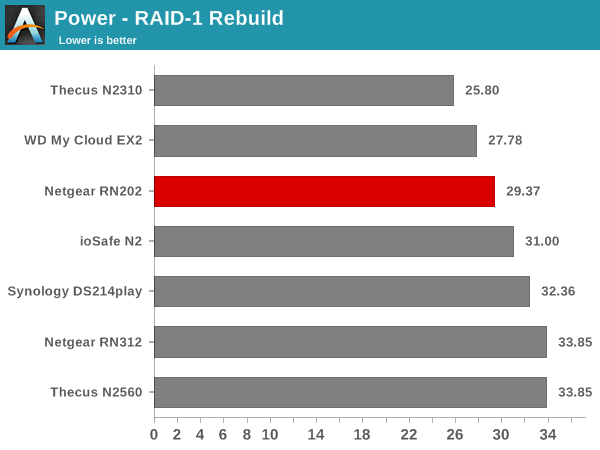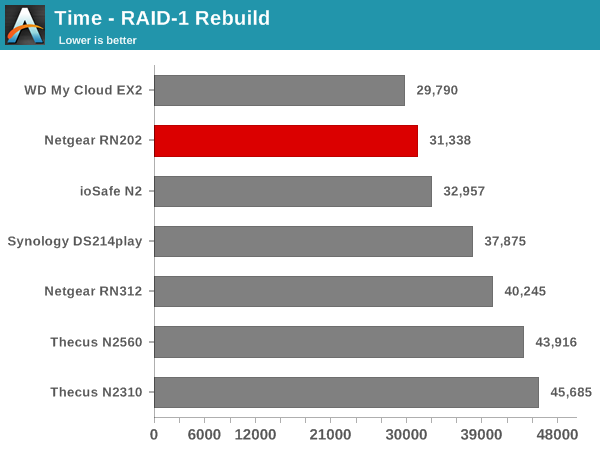Netgear ReadyNAS RN202 2-bay NAS Review
by Ganesh T S on September 25, 2015 2:30 PM EST- Posted in
- NAS
- Storage
- NetGear
- Annapurna Labs
Miscellaneous Aspects and Final Words
In order to keep testing consistent across all 2-bay units, we performed all our expansion / rebuild testing as well as power consumption evaluation with the unit configured in RAID-1. The disks used for benchmarking (Western Digital WD4000FYYZ) were also used in this section. The table below presents the average power consumption of the unit as well as time taken for various RAID-related activities.
| Netgear RN202 RAID Expansion and Rebuild / Power Consumption | ||
| Activity | Duration (HH:MM:SS) | Avg. Power (W) |
| Single Disk Init | - | 18.55 W |
| JBOD to RAID-1 Migration | 08:45:42 | 29.33 W |
| RAID-1 Rebuild | 08:42:18 | 29.37 W |
The graphs below show the power consumption and rebuild duration when repairing a RAID-1 volume for the various 2-bay NAS units that have been evaluated before.

The Netgear RN202 is not the fastest or most power efficient system when it comes to RAID rebuilt, but it is in the top half of the set of 2-bay units that we have evaluated so far.

Concluding Remarks
The Annapurna Labs ARM Cortex A15 platform provides more CPU power and has the appropriate hardware acceleration blocks for the NAS market. With only two bays, the unit is more suited for home consumers. Even though link aggregatin is supported, the platform can't saturate the bonded link (topping out around 170 MBps in the real life workloads that we tested). However, in the space where ARM-based units tend to not support 802.3ad link aggregation, the RN202 is definitely better placed.
In our opinion, the Netgear ReadyNAS RN202 and ReadyNAS OS stand out in the crowded NAS market because of the btrfs support and the set of business features that enable interesting use-cases in the consumer market. Netgear's extensive networking background also allows for seamless VPN and cloud integration in ReadyNAS OS 6.
One of the interesting business features that Netgear has enabled in the RN202 is 'ReadyNAS Replicate'. This allows two ReadyNAS units connected to the Internet (and associated with the same ReadyCLOUD account) to be able to back up to each other via a secure peer-to-peer connection. This feature enables easy configuration of off-site backups. With certain tweaks (such as ability to do backups to a ReadyNAS associated with a different account), this feature could do well in the consumer market.
On the whole, ReadyNAS OS has slightly more than the bare minimum feature set required of a modern commercial off-the-shelf NAS operating system. The ReadyNAS RN202's hardware feature set makes is a good candidate for home consumers and SOHO installations. Taken in the context of units such as the QNAP TS-231 (with two network links and a sub-$200 price tag), the $282 diskless pricing of the RN202 is a bit too high for our liking.











22 Comments
View All Comments
Duncan Macdonald - Friday, September 25, 2015 - link
Any NAS system that is limited to GbE or lower speed will give poor performance compared to even budget SSDs. (A GbE link can transfer about 100MB/sec after allowing for overheads - even low performance SSDs can do much better.) To beat locally mounted SSDs requires 10GbE or faster links. NAS systems are only useful for sharing files (slowly) to multiple computers or providing a backup far enough away to be unlikely to be affected by a common disaster (eg a house fire).As for NAS systems with 100Mb/sec links - AVOID (A USB 2.0 stick can be faster!!!)
BillyONeal - Friday, September 25, 2015 - link
But most of the NASes here are well below saturating GigE. A USB 2.0 stick can be faster in extremely limited scenarios but in most cases USB protocol overhead per transfer will make it worse for these kinds of workloads.Metaluna - Friday, September 25, 2015 - link
Where in the article did anyone suggest using a NAS as a performance alternative to locally attached SSDs? And as for NAS only being useful for sharing files to multiple computers, yeah, that's kind of the whole point for why local area networks and file servers were developed in the first place. That's like saying "A GPU is really only useful for displaying images on your screen"colinstu - Friday, September 25, 2015 - link
don't know what 'overheads' you're talking about but my Synology NAS and gb network regularly transfer at 115MB/s (114-116). Still not the max theoretical of 125MB/s, but closer to the max then '100'azazel1024 - Saturday, September 26, 2015 - link
No, max theoretical is not 125MB/sec. That is raw data rate, but you can't actually transfer 125MB/sec of usable data over a 1GbE link. SMB max rate is about 117.5MB/sec using 9k jumbo frames and about 115MB/sec using standard 1500MTU. That is covering TCP/IP overhead as well as SMB overhead. Smaller file will reduce the max by a bit no matter how fast the host and server are because of additional SMB overhead involved in "opening" and "closing" each file transfer.NAS are just fine, at least newer moderately fast ones. But, I do have to say, if running windows based clients...a windows based server, if you can't/don't want to move to 10GbE can be significantly higher performing than a NAS, even in "undemanding" file transfers. My G1610 based server manages 235MB/sec between it and my desktop, both running Windows 8.1. Dual GbE NICs combined with SMB Multichannel is a beautiful thing.
UtilityMax - Sunday, September 27, 2015 - link
NAS storage is slower than a directly attached storage! Shocking stuff! News at 11.GiE is is actually pretty acceptable for most applications, except a few specialist tasks. 10GbE can still be pretty expensive and power hungry.
UtilityMax - Sunday, September 27, 2015 - link
Sorry mean 10GbE instead of GiEWixman666 - Sunday, September 27, 2015 - link
So you decided that comparing apples and walruses is ok? A SSD and a 2 bay NAS have nothing in common for function, capacity, or price. Troll on, dude.johnny_boy - Thursday, October 1, 2015 - link
Any SSD system that is limited to SATA or even PCIE will give poor performance compared to even budget RAM disks. (A SATA link can transfer about blah MB/sec after allowing for overheads - even low performance RAM disks can do much better.) To beat locally mounted RAM disks requires bleek GbE or faster links. SSDs are only useful for reading and writing data.As for SSDs with blomps Mb/sec links - AVOID (A USB 3.0 stick can be faster!!!)
Wardrop - Friday, September 25, 2015 - link
Do the btrfs snapshots show up in Windows under the "Previous versions" tab?